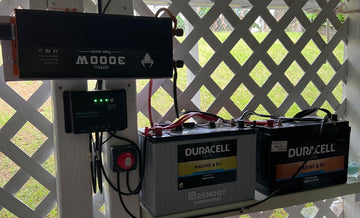Battery acid, often referred to as sulphuric acid used in lead acid batteries, is a highly corrosive chemical. This liquid is not only used in batteries, but is also used in a wide variety of industrial and chemical processes. Understanding the dangers of battery acid is critical to protecting individuals and the environment.
Table of contents:
Properties of Battery Acid
Battery Acid, with sulfuric acid as the main component, has physical and chemical properties such as strong corrosiveness, flammability and toxicity. Battery Acid plays a key role in batteries by reacting with both the positive and negative electrodes to generate an electric current that provides the energy needed by the device.
However, it is these very properties that make battery acid extremely dangerous when not handled properly. Its highly concentrated corrosive properties allow it to quickly destroy most materials, especially metals and organics. The toxicity of battery acid not only affects the health of the user, but can also cause serious damage to the environment.

When are people exposed to battery acid?
- Battery maintenance: when replacing, charging or servicing lead acid batteries.
- Industrial use: Battery acid is used for power and chemical synthesis in certain industrial processes.
- Accidents: When a battery is broken or leaking, this may result in battery acid leaking into the surrounding environment.
Potential Hazards of Battery Acid
Human Hazards of Battery Acid
Battery acid is harmful to the environment

Preventive and Treatment Measures
- In terms of personal protection, wear appropriate personal protective equipment (PPE) such as gloves, goggles and protective clothing when handling batteries. Also, keep the work area well ventilated to reduce the build-up of battery acid vapours.
- For battery storage and transport, store batteries in a dry, cool place away from flammable materials. During transport, ensure that the battery packaging is intact and securely fastened to prevent accidental leakage.
- For the disposal of used batteries, we should encourage the use of battery recycling services. Disposing of used batteries through professional recycling channels not only reduces environmental pollution, but also recycles the valuable materials in them. At the same time, prohibiting the indiscriminate disposal of batteries is also a necessary measure to protect the environment.
- In terms of emergency response, we should formulate a detailed emergency response plan. In the event of an accident such as battery acid leakage, initial response measures should be taken immediately, such as isolating the leaking area and evacuating people. At the same time, emergency services and environmental protection departments should be contacted promptly for professional treatment and rescue.
Responding to a Battery Acid Emergency
If you are unfortunate enough to come into contact with battery acid, it is critical that you respond quickly and appropriately.
If battery acid is splashed on the skin, take the following steps immediately to minimise the risk of injury:
- Immediate Flushing: First, immediately flush the affected skin area with plenty of water. The water flow should be continuous and strong to dilute and wash away as much battery acid as possible from the skin. Flushing should continue for at least 15 minutes, or until all battery acid has been rinsed from the skin.
- Remove Clothing: If Battery Acid has been spilled on clothing and has penetrated the skin, the contaminated clothing should be removed immediately to prevent the Battery Acid from continuing to cause skin damage. Take special care when removing clothing to avoid further irritation or damage to the skin.
- Do not rub or wipe: When dealing with battery acid splashes on the skin, remember not to rub or wipe the affected skin area. Doing so may aggravate the injury by allowing the battery acid to penetrate deeper into the skin.
- Seek medical attention: After initial self-treatment, seek medical attention immediately. Even if the battery acid has been rinsed from the skin, it may have caused damage to the skin that requires professional treatment.
- Inform the doctor: When seeking medical attention, inform the doctor in detail about the type of battery acid, how long it has been splashed on the skin and the treatment measures that have been taken. This will help the doctor to better assess the extent of the damage and develop an appropriate treatment plan.
Proper Battery Disposal and Recycling
Proper handling of batteries is critical, especially types that contain hazardous components such as lead-acid and lithium batteries . When handling batteries, start by wearing protective gear such as gloves and goggles to prevent chemical damage to your skin and eyes. Store used batteries in a dry, cool place and make sure they don't come into contact with each other to avoid short circuits and fire hazards. Special care should be taken to collect different types of batteries separately for subsequent recycling.
When recycling batteries, look for a specialised local recycling point or retailer, many of which offer a free or convenient battery recycling service. Ensure that you are aware of local regulations and recycling requirements to comply with environmental standards. In addition, participating in environmental activities in your community and educating others about the importance of battery recycling will help raise public awareness and reduce the impact of hazardous substances on the environment. Through proper disposal and recycling, we can contribute to sustainable development.

Lithium LiFePO4 Batteries: A Safer Alternative
Compared to lead-acid batteries, lithium-iron-phosphoric acid (LiFePO4) batteries are attracting a lot of attention because of their higher energy density and safety. The chemical stability of LiFePO4 batteries makes them less prone to leaks and fires, while their longer lifespan reduces their environmental impact by reducing the frequency of replacement. Lithium batteries are gradually replacing traditional lead-acid batteries in many applications as a more environmentally friendly and safer option.
High Safety
Lithium LiFePO4 batteries have high thermal stability and low combustibility, which makes them less prone to fires or explosions than other types of lithium-ion batteries in the event of failures such as short circuits, overcharging or overheating. This feature makes lithium LiFePO4 batteries have a wide range of application prospects in electric vehicles, energy storage systems and other fields, and can provide users with safer and more reliable energy security.
Strong environmental protection
The environmental friendliness of LiFePO4 battery is mainly reflected in the selection of materials and production process. The battery does not contain heavy metals such as lead, cadmium and other harmful substances, environmentally friendly. At the same time, the recycling of lithium LiFePO4 batteries is also relatively simple, and its materials can be recycled and reused, which helps to reduce the waste of resources and environmental pollution. In addition, lithium LiFePO4 batteries have a long cycle life, which reduces the frequency of battery replacement and further reduces the burden on the environment.
Best LiFePO4 batteries

This LiFePO4 (lithium) battery lasts up to 8 to 10 times longer than conventional lead-acid batteries, with a cycle count from 2,000 to 5,000, far exceeding that of lead-acid batteries, which is 300 to 500 cycles. Their usable capacity is twice that of lead-acid batteries, while their weight has been reduced by 30 per cent, thanks to their significantly higher energy density. Lithium batteries have no memory effect and can hold their charge better when not in use, and will not lose capacity due to their previous state of discharge.
The battery has a built-in Battery Management System (BMS), which effectively prevents overcharging, over-discharging, over-current and short-circuit, and has an excellent self-discharge rate. The built-in high-temperature cut-off function prevents the battery from charging above 122°F (50°C). Compared to lead-acid batteries, lithium-ion batteries are superior in safety because they are protected against ground faults. Suitable for both indoor and outdoor applications, this battery supports parallel and series connections to expand capacity and voltage up to 48V in series and 400AH in parallel.Additionally, its low-temperature cut-off feature prevents irreversible damage to the battery when charging at low temperatures (32°F/0°C), making it suitable for most marine environments. The batteries are medium sized and come in black and orange colours, and are widely used in a variety of applications such as home energy storage systems, UPS backups, lighting, digital/CCTV cameras, portable TVs, electronic robots, electric cars, DIY speakers, 12V routers, air pumps, fishfinders, RVs, yachts, travel trailers, dump trailers and many more.
Summary
Battery acid (sulphuric acid) is a highly hazardous chemical with potential threats to health and the environment. By understanding the characteristics of battery acid, the potential risks and the corresponding preventive and countermeasures, individuals and society can take effective action to protect themselves and the environment. The shift to safer alternatives such as lithium batteries is also an important direction for future battery technology development.
FAQs
How do I recognise a battery acid leak?
Battery acid leaks may cause corrosion, discolouration or dripping from the battery case. Leaks may be accompanied by a pungent, acidic taste or odour.
What are the health effects of battery acid?
Battery acid in contact with the skin may cause burns, redness, swelling and pain. If vapours are inhaled, they may cause respiratory irritation, and prolonged exposure may cause more serious health problems.
How do I deal with a battery acid leak?
If you discover a battery acid spill, evacuate the site immediately and cover the spill area with sand, lime or other appropriate absorbent material. A professional hazardous waste disposal organisation should then be contacted for disposal.
How to store battery acid safely?
Battery acid should be stored in a dry, cool, well-ventilated area, avoiding contact with flammable materials and making sure containers are well sealed. In addition, warning signs should be posted in the storage area to alert others.
Do I need a professional to handle battery acid?
Yes, the handling of battery acid and spills requires specialised personnel, especially if the scale is large or the spill is serious. Amateur handling may lead to further danger.
I have heard of environmentally friendly battery acid, is it reliable?
Eco-friendly battery acid usually refers to the use of less harmful ingredients or improved battery designs, but proper handling and recycling processes still need to be followed to ensure safety and environmental protection.
How can I reduce the risk of battery acid at home?
Avoid placing batteries in areas with high temperatures, humidity or direct sunlight, and regularly check batteries for signs of leakage or damage. Educate your family on the safe use and disposal of batteries.













